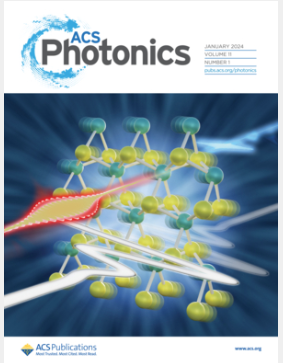Switchable Photon-Plasmon Coupling in a Single-Nanoparticle-Perturbed Microcavity
IF 6.5
1区 物理与天体物理
Q1 MATERIALS SCIENCE, MULTIDISCIPLINARY
引用次数: 0
Abstract
Single plasmonic nanoparticles coupled to a whispering-gallery-mode (WGM) microcavity provide an excellent platform to explore enhanced light–matter interactions. Here, we demonstrate switchable coupling between localized surface plasmon resonances (LSPRs) and three-dimensionally (3D) confined WGMs in an optoplasmonic system composed of a single gold nanorod and a microtubular cavity. The photon–plasmon coupling is efficiently switched between an “ON” and “OFF” state by tuning the excitation of the LSPR to match or mismatch the WGMs, where spectral match and spatial overlap play crucial roles. This switching phenomenon is indicated by the observations of spectral energy shifts, intensity variations, and spatial redistributions of the 3D confined WGMs. To explain the observed results, a deformed potential well model is introduced based on perturbation theory, where the polarizability and enhanced electric field induced by the single plasmonic nanorod are considered. The present work provides a convenient way to manipulate the photon–plasmon coupling in a hybrid optoplasmonic system, paving the way for controllable light–matter interactions and opening up promising applications in future subwavelength photonic technologies.

单纳米粒子微腔中可切换光子-等离子体耦合
单等离子体纳米粒子耦合到微腔低语-走廊模式(WGM)提供了一个很好的平台来探索增强的光-物质相互作用。在这里,我们展示了在由单个金纳米棒和微管腔组成的光等离子体系统中,局部表面等离子体共振(LSPRs)和三维受限WGMs之间的可切换耦合。通过调节LSPR的激发来匹配或不匹配wgm,光子-等离子体耦合在“开”和“关”状态之间有效地切换,其中光谱匹配和空间重叠起着至关重要的作用。这种开关现象可以通过观察三维受限wgm的光谱能量位移、强度变化和空间重分布来说明。为了解释观测结果,引入了一种基于微扰理论的变形势阱模型,该模型考虑了单等离子体纳米棒的极化率和增强电场。本研究为在混合光等离子体系统中控制光子-等离子体耦合提供了一种方便的方法,为可控光-物质相互作用铺平了道路,并为未来亚波长光子技术的应用开辟了广阔的前景。
本文章由计算机程序翻译,如有差异,请以英文原文为准。
求助全文
约1分钟内获得全文
求助全文
来源期刊

ACS Photonics
NANOSCIENCE & NANOTECHNOLOGY-MATERIALS SCIENCE, MULTIDISCIPLINARY
CiteScore
11.90
自引率
5.70%
发文量
438
审稿时长
2.3 months
期刊介绍:
Published as soon as accepted and summarized in monthly issues, ACS Photonics will publish Research Articles, Letters, Perspectives, and Reviews, to encompass the full scope of published research in this field.
 求助内容:
求助内容: 应助结果提醒方式:
应助结果提醒方式:


